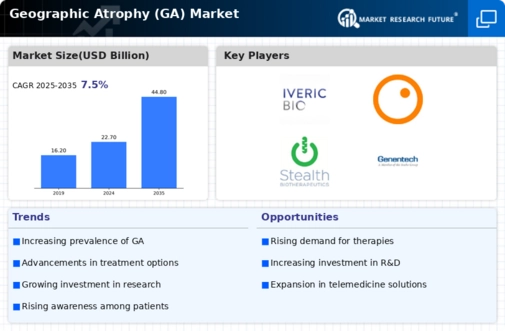Geographic Atrophy GA Market Summary
As per MRFR analysis, the Geographic Atrophy (GA) Market. Size was estimated at 23.19 USD Billion in 2024. The Geographic Atrophy industry is projected to grow from 24.93 USD Billion in 2025 to 51.39 USD Billion by 2035, exhibiting a compound annual growth rate (CAGR) of 7.5 during the forecast period 2025 - 2035.
Key Market Trends & Highlights
The Geographic Atrophy market is poised for substantial growth driven by innovative therapies and increasing awareness.
- The North American market remains the largest, fueled by advanced healthcare infrastructure and high patient awareness.
- The Asia-Pacific region is emerging as the fastest-growing market, likely due to increasing healthcare investments and a rising aging population.
- The segment of patients above 75 years constitutes the largest demographic, whereas those above 60 years are experiencing the fastest growth.
- Key market drivers include the aging population and advancements in diagnostic technologies, which are propelling research and development efforts.
Market Size & Forecast
| 2024 Market Size | 23.19 (USD Billion) |
| 2035 Market Size | 51.39 (USD Billion) |
| CAGR (2025 - 2035) | 7.5% |
Major Players
Novartis (CH), Regeneron Pharmaceuticals (US), Roche (CH), Bayer (DE), Apellis Pharmaceuticals (US), Alcon (CH), Santen Pharmaceutical (JP), Zeiss (DE), Horizon Therapeutics (IE)


















Leave a Comment